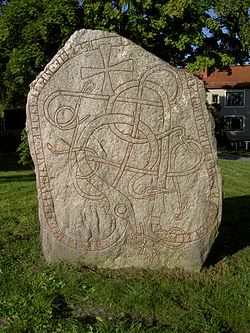
The Vaksala Runestone, designated as U 961 under the Rundata catalog, is a Viking Age memorial runestone that is located close to Vaksala Church, near Uppsala, Sweden.

This runic inscription, designated as U Fv1976;107 under the Rundata catalog, is located at the Uppsala Cathedral in Uppsala, Sweden.

Uppland Runic Inscription 613, also known as the Torsätra runestone, is the Rundata catalog number for a Viking Age memorial runestone originally located in Torsätra, which is approximately 8 kilometers northeast of Bro, Stockholm County, Sweden, which is in the historic province of Uppland.

Öpir or Öper was a runemaster who flourished during the late 11th century and early 12th century in Uppland, Sweden. He was the most productive of all the old runemasters and his art is classified as being in the highly refined Urnes style.

Fot was a runemaster who flourished in mid-11th century Sweden.
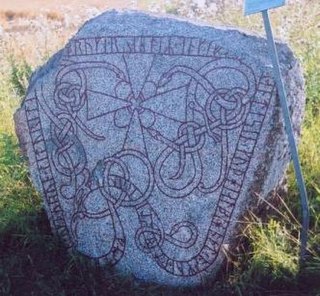
Åsmund Kåresson was a Viking Age runemaster who flourished during the first half of the 11th century in Uppland and Gästrikland, Sweden. The early Urnes style is represented in his art.

The Granby Runestone, designated as U 337 under the Rundata catalog, is one of the longest Viking Age runic inscriptions located in Uppland, Sweden.
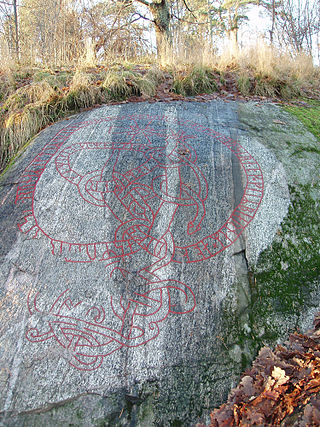
Runic inscription U Fv1986;84 is the Rundata catalog number for a Viking Age memorial that is located at Bo gård on the island of Lidingö in Uppland, Sweden.

Uppland Runic Inscription 308 or U 308 is the Rundata catalog designation for a memorial runestone that is located in Ekeby, Stockholm County, Sweden, which was in the historic province of Uppland. While the tradition of carving inscriptions into boulders began in the 4th century and lasted into the 12th century, most runestones date from the late Viking Age.

This runic inscription, designated as U Fv1948;168 in the Rundata catalog, is on a Viking Age memorial runestone to two sons that is located in Alsike, Uppsala County, Sweden, which is in the historic province of Uppland.

This runic inscription, designated as U Fv1976;104 in the Rundata catalog, is on a Viking Age memorial runestone that is located at the Uppsala Cathedral, Uppland, Sweden.
The Lilla Vilunda runestones are three Viking Age memorial runestones that were erected by members of the same family and which are located at Lilla Vilunda in Upplands Väsby, Stockholm County, Sweden, and in the historic province of Uppland.

The Björklinge runestones are five Viking Age memorial runestones designated in the Rundata catalog as U 1045, U 1046, U 1047, U 1048, and U 1050 that are located at the church in Björklinge, Uppsala County, Sweden, which is in the historic province of Uppland. In addition, there is a small fragment of a runestone with a partial runic text i * lit * rita * meaning "had erected" that has been given the catalog number U 1049.

Södermanland Runic Inscription 158 or Sö 158 is the Rundata catalog number for a Viking Age memorial runestone located in Österberga, which is one kilometer southwest of Ärsta and three kilometers southwest of Runtuna, Södermanland County, Sweden, and in the historic province of Södermanland. The inscription includes an image of a ship and uses same-stave bind runes to commemorate a man described as being a thegn.

Uppland Runic Inscription 181 or U 181 is the Rundata catalog number for a Viking Age memorial runestone located at Össeby-Garn, which is about one kilometer east of Karby, Uppsala County, Sweden.
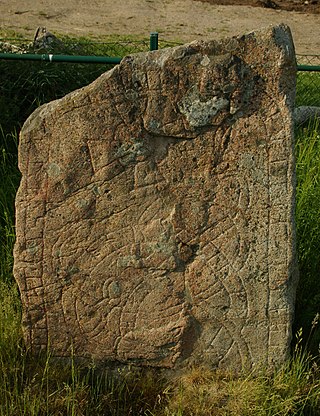
Uppland Runic Inscription 993 or U 993 is the Rundata catalog number for a Viking Age memorial runestone located in Brunnby, which is one kilometer west of Gunsta, Uppsala County, Sweden, which was part of the historical province of Uppland.
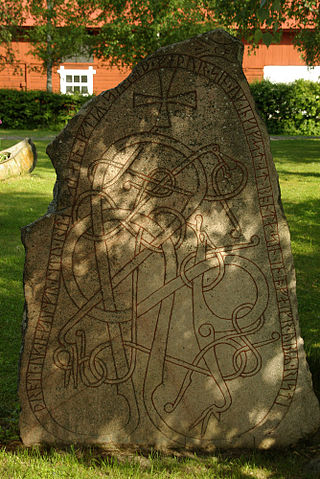
Uppland Runic Inscription 485 or U 485 is the Rundata catalog number for a Viking Age memorial runestone that is located in Marma, which is about six kilometers northeast of Knivsta, Uppsala County, Sweden, which was in the historic province of Uppland.
Uppland Runic Inscription 896 or U 896 is the Rundata catalog listing for a Viking Age memorial runestone originally located at Håga in the historic province of Uppland, Sweden, but is now at the Universitetsparken of Uppsala University.

Uppland Runic Inscription 1158 or U 1158 is the Rundata catalogue listing for a Viking Age memorial runestone that is located at Stora Salfors, which is one kilometre east of Fjärdhundra, Uppsala County, Sweden, and is in the historic province of Uppland. The stone is a memorial to a man named Freygeirr, and may have been the same Freygeirr who was a Viking chieftain active on the Baltic coast in the 1050s.

The Bolsta Runestones are two Viking Age memorial runestones and two fragments of a third that are located in Bolsta, which is on the east edge of Uppsala, Uppsala County, Sweden, and in the historic province of Uppland. One runestone is signed by the runemaster with the normalized name of Åsmund Kåresson and the other by the runemaster named Öpir.
